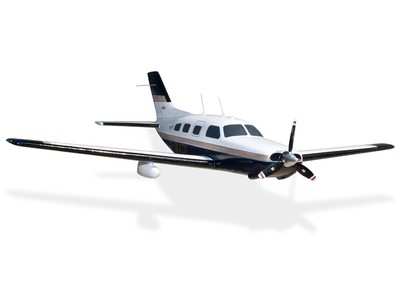The Perils of Latency
On 03 March 2020 at approximately 16:34 EST, a Piper PA-46-310-P Malibu, registration N43368, was destroyed, and its three occupants killed in a weather-related accident near Bishop, Georgia—a hamlet some 48-nautical-miles northeast of Atlanta.

The personal flight was conducted under Part 91 of the Federal Aviation Regulations and commanded by a 62-year-old, instrument rated private pilot with an estimated 1,178 total flight hours. Subject pilot filed an IFR flight-plan prior to departing Columbia, South Carolina’s Columbia Metropolitan Airport (CAE) and starting toward his filed destination of Alabama’s Tuscaloosa Regional Airport (TCL).
At approximately 16:16 EST, while proceeding on a westerly track at 6,000-feet MSL, the pilot contacted Atlanta approach control and was provided the current altimeter and AIRMETs for IFR conditions, mountain obscuration, and turbulence.
At 16:21 EST, the pilot requested a course deviation to circumvent a line of weather. The request was approved. Eight-minutes later, the controller advised the pilot of a gap in the line of weather through which the Malibu could be vectored toward more favorable flight conditions.
At 16:30 EST, the controller instructed the pilot to fly heading 300°—a vector the pilot advised would take the aircraft “straight into a buildup.” The controller assured the pilot of his intentions to keep the flight south of the heaviest precipitation before issuing a northerly vector that would take it through a three-mile gap in the line. The pilot, however, stated the area to which the controller alluded appeared to be quickly closing in.
The controller acknowledged the pilot’s transmission, stating he could instead vector the flight south of Atlanta—a considerable deviation.
The pilot declined the alternative, stating he would accept the northerly routing. The controller subsequently instructed the pilot to take up a heading of 300°, informing the aviator that the vector would keep him out of the moderate precipitation.
Vexed, the pilot responded: “I thought I was gonna shoot this gap here, I got a gap I can go straight through.”
The controller acknowledged, authorizing the pilot to proceed—provided he’d identified a safer course. The controller warned, however, that ATC radar showed moderate precipitation starting approximately one-mile [from the aircraft’s position] and extending north another four-miles. The pilot acknowledged.
At 16:33 EST, the controller inquired after the pilot’s flight conditions. “Rain, three-six-eight,” the pilot responded.
The transmission was the last received from N43368.
Radar information indicated the aircraft proceeded into an area of heavy to very-heavy precipitation—likely a rain shower updraft—while in instrument meteorological conditions. The PA-46 then entered a right, descending spiral and broke up in flight.
The aircraft impacted a wooded area behind a residential property. All major airframe and powerplant components were accounted for at the scene. The main wreckage consisted of the Malibu’s fuselage and engine.
The aircraft’s wings, empennage, and constituent components were scattered along a 1⁄2-mile debris-trail. The starboard side of the fuselage was destroyed by a post-impact fire. Examination of the wreckage—to include primary flight control rigging, forensic powerplant reconstruction , and airframe integrity revealed no evidence of pre-accident malfunction or failure.
The airplane carried equipment capable of displaying weather radar "mosaic" imagery created from Next Generation Radar (NEXRAD) and available via the flight information service-broadcast (FIS-B) and private satellite weather service providers. A mosaic comprises radar data from multiple ground sites composited into a single image presented on a cockpit display. Investigators posit the pilot of N43368 was using and relying upon such data to navigate around convective weather along his route.
Due to latencies inherent the processes of detecting NEXRAD data and delivering it to ground-sites and creating the mosaic images disseminated by the service provider, NEXRAD data can differ dramatically from real-time weather conditions. In point of fact, meteorological phenomena depicted on mosaic images are always older than the age indicated on the cockpit display. In extreme instances, the actual age of the oldest NEXRAD data in a given mosaic can EXCEED the age indicated to the reader/pilot by as much as 15 to 20 minutes.

By predicating key Pilot In Command (PIC) decisions on mosaic weather data instead of ATC recommendations, the pilot of N43368 inadvertently entered hazardous meteorological conditions, the severity of which occasioned a loss of aircraft control and a subsequent in-flight breakup.
In its 20 December 2022 final report, the National Transportation Safety Board (NTSB) ascribed the accident’s probable cause as:
“The pilot’s encounter with a rain shower updraft and severe turbulence, which resulted in a loss of airplane control and an inflight breakup. Contributing to the accident was the pilot’s reliance on outdated weather information on his in-cockpit weather display.”
The deceased pilot had a valid subscription to XM data. What’s more, a Garmin GMX-200, which would support XM data, was found in the wreckage. The XM data was a weather radar service provided by XM Sirius and displayed on the Garmin GMX-200. However, the Garmin GMX-200 Pilot’s Guide states: “This software is not designed or intended for use or resale in hazardous environments requiring fail-safe performance, such as aircraft navigation.”
 ANN's Daily Aero-Term (04.24.24): Runway Lead-in Light System
ANN's Daily Aero-Term (04.24.24): Runway Lead-in Light System ANN's Daily Aero-Linx (04.24.24)
ANN's Daily Aero-Linx (04.24.24) Aero-FAQ: Dave Juwel's Aviation Marketing Stories -- ITBOA BNITBOB
Aero-FAQ: Dave Juwel's Aviation Marketing Stories -- ITBOA BNITBOB Classic Aero-TV: Best Seat in The House -- 'Inside' The AeroShell Aerobatic Team
Classic Aero-TV: Best Seat in The House -- 'Inside' The AeroShell Aerobatic Team Airborne Affordable Flyers 04.18.24: CarbonCub UL, Fisher, Affordable Flyer Expo
Airborne Affordable Flyers 04.18.24: CarbonCub UL, Fisher, Affordable Flyer Expo




